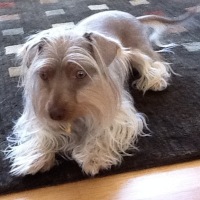Appearance of the Crestoxie
|
| The Crestoxie is a very small dog, generally measuring less than 30.5 centimeters in height, with a longer back than the dog is tall, although this difference is more evident in dogs that favor the Dachshund structure. Crestoxies may inherit the long slender legs of the Chinese Crested Dog or the short piston-like legs of the Dachshund, or they may even end up with something in between, although the shorter and longer bodies seem to be more prominent. Their head is likely to be slightly narrower than most, with a long, tapering muzzle and almond-shaped eyes, and although the ears are set high on the sides of the head, they can be either erect and triangular in shape, or rounded and hanging down to the sides. The gene that leads to hairlessness in the Chinese Crested Dog is a dominant gene that also proves lethal during gestation if the animal carries two copies of the gene, so that every living Chinese Crested Dog carries both the dominant hairless gene as well as the recessive gene. which produces the Powderpuff variety of dog that is entirely covered by a thick, silky double coat. This means that the coat coverage of this dog can range from full coverage to just the crest of the head, the plume of the tail and the socks of the Chinese Crested Dog. The outer coat can vary in length from short to medium and can be soft and glossy like the Smooth Longhaired Dachshund, silky like the Chinese Crested Dog, or even stiff like the Wirehaired Dachshund. |
Temperament of the Crestoxie
|
| The Crestoxie is an intelligent, lively dog, generally displaying the bravery of the Dachshund and the ardor of the Chinese Crested Dog. This particular hybrid is very content as they are fully integrated into family activities, and as both parent breeds are inquisitive dogs, mental stimulation will be needed throughout the day to keep them from running into trouble. They are intelligent but tend to be stubborn and obstinate during obedience training sessions, and both parent breeds are notoriously difficult to train. Training sessions must remain consistent with this breed throughout their lives to engage their minds and curb destructive or manipulative behavior. Although they do quite well with well-behaved older children, the Crestoxie is an inappropriate companion for very small or boisterous children. Not only is the risk of injury to the dog from rough or clumsy handling by the child higher due to the dog's size and elongated back, but Chinese Crested and Dachshund breeds are prone to bites due to jealousy and possessiveness. |
Needs and activities of the Crestoxie
|
| The Crestoxie has relatively simple needs when it comes to daily exercise, and they are generally content with 20 to 40 minutes of vigorous activity a day. Activity divided into smaller, more frequent sessions is most beneficial to this animal's health, and many enjoy indoor games of fetch and scent activities, as well as a few leashed walks each day. These small dogs are generally well adapted to life in smaller spaces due to these reduced exercise requirements. However, some dogs will be prone to excessive barking, especially if they're in a group, which can make them noisy neighbors. These are curious, active dogs, and mental stimulation must be provided throughout the day to avoid destructive behavior. It's important to be cautious when this hybrid is in its growth phase to ensure it doesn't play too hard or jump from high surfaces, as this could injure the developing back. |
Maintenance of the Crestoxie
|
| Grooming requirements for this particular hybrid will depend somewhat on the type of coat they have inherited. Crestoxies that are mostly hairless will require more frequent bathing, although brushing takes very little time, while the fully coated variety generally requires fewer baths, but will need more regular combing and brushing to remove dead hairs and prevent tangles and mats from forming in the coat. The skin of the Chinese Crested Dog is prone to irritation, particularly the exposed skin of the hairless variety, and Crestoxie can also inherit this trait. This means that finding a good shampoo that doesn't irritate your dog's skin is essential to his health, as is looking for problems such as rashes, acne or swollen skin every time you bathe him. If the outer coat resembles that of the Wirehaired Dachshund, manual stripping may also be necessary to keep this stiff outer coat clean and healthy. These dogs can experience more dental problems than many breeds, and regular dental maintenance, such as tooth brushing and dental examinations, can help prevent certain problems or detect them early. |









 English (United Kingdom)
English (United Kingdom)